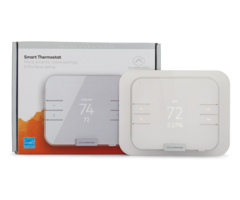How Do I Use Emergency Mode for Auxiliary Heat On the ADC-T3000?
You can use Emergency Mode for Auxiliary Heat on the ADC-T3000 Thermostat by choosing the EMER option within the MODE Menu. In Emergency Mode, the heat pump is bypassed, and only auxiliary heating is used. Bypassing the heat pump can make it possible to heat the building more quickly.
 In the context of the Alarm.com ADC-T3000 Smart Thermostat, auxiliary heat identifies an alternative heat source in a heat pump system that is not the heat pump itself. An auxiliary heat source should be connected to the W terminals on the ADC-T3000. A typical auxiliary heat source will use electric or gas power, and it will provide shorter, more powerful heating sessions than what an ordinary heat pump is able to provide. Keep in mind that auxiliary heaters tend to use more energy, and their use will typically result in a more expensive energy bill for the end user when used frequently. Using an auxiliary heating source should only be a temporary solution that is used to supplement the heat pump that serves as the primary heater.
In the context of the Alarm.com ADC-T3000 Smart Thermostat, auxiliary heat identifies an alternative heat source in a heat pump system that is not the heat pump itself. An auxiliary heat source should be connected to the W terminals on the ADC-T3000. A typical auxiliary heat source will use electric or gas power, and it will provide shorter, more powerful heating sessions than what an ordinary heat pump is able to provide. Keep in mind that auxiliary heaters tend to use more energy, and their use will typically result in a more expensive energy bill for the end user when used frequently. Using an auxiliary heating source should only be a temporary solution that is used to supplement the heat pump that serves as the primary heater.
The purpose of Emergency Mode on the ADC-T3000 Thermostat is to override the heat pump and rely solely on the auxiliary heating source. This is normally done when the weather drops to some of its lowest temperatures in the area, and the heat pump simply cannot keep up. The auxiliary heater will usually be a bit stronger and able to get the building warm enough to where the heat pump can then step-in and keep the temperature stable. Additionally, some heat pumps are known to become ineffective when the outside temperature drops too low. If that is the case, then using the auxiliary heating source might be the only way to prevent the building temperature from dropping any further. In an extreme case, you might need to use the auxiliary heater to prevent serious damage from frozen pipes.
While a heat pump may not be as strong as the auxiliary heater, it will usually be better-suited in operating for a long period of time. Therefore, a heat pump will normally represent the primary solution for keeping the building comfortable. Using Emergency Mode and an auxiliary heating source should only be done in emergency situations where you need to quickly step-in and prevent an otherwise free-falling temperature. In other words, Emergency Mode should only be used in low-temperature emergencies, hence the name, Emergency Mode. Once the temperature has stabilized and the heat pump can effectively perform its duties, take the ADC-T3000 off of Emergency Mode, and return it to its standard HEAT or AUTO setting.
For this FAQ, we will assume that the auxiliary heater has already been configured to work when the thermostat is set to Emergency Mode. If you are unsure how to properly wire the thermostat, you should consult with a licensed HVAC professional. We will just be covering how to set the thermostat to its Emergency Mode. Complete the following steps to put the Alarm.com ADC-T300 Thermostat in Emergency Mode:
1. Access Mode Menu. Go to the ADC-T3000 Thermostat. Press the - button in the upper left. Then select the MODE option. The thermostat will be in its Mode Menu.
2. Enter Emergency Mode. Scroll through the list of Modes. Any Mode that is available based on the system configuration will be accessible. The possible options include HEAT, COOL, AUTO, EMER, and OFF. Set the thermostat to EMER Mode. EMER is short for Emergency.
3. Verify Emergency Mode. When the ADC-T3000 is in its Emergency Mode, it should flash EMER whenever the display turns back on. The message HEAT will be shown at the top of the screen. If you exit HEAT Mode, you will also be exiting Emergency Mode. While you are in Emergency Mode, you can use the up and down arrows to adjust the desired heating setpoints just like you would if the thermostat was in its standard Heating Mode.
Did you find this answer useful?
We offer alarm monitoring as low as $10 / month
Click Here to Learn MoreRelated Products

Related Categories
- Answered
